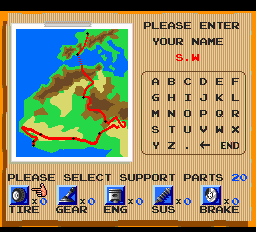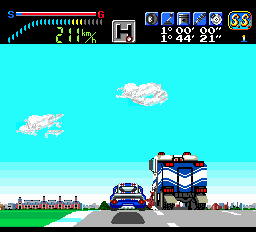To complete Victory Run, you must make it through all eight courses in the entire Paris-Dakar Rally before your total allowed race time is reduced to 0. You must complete each course, in its entirety, before you are permitted to advance to the next course. When you advance, you will have an opportunity to replace any used car parts with the supply of parts that you selected at the beginning of the game.
Parts strategy[edit]
Selecting parts[edit]

When you begin a new game, you are presented with a screen that first asks you to enter your initials. Then it asks how you would like to distribute your 20 replacement supplies among the five available parts. Choosing the good distribution of parts is essential to completing the game. Below are some good and bad examples of how your parts can be distributed. T = Tires, G = Gears, E = Engine, S = Suspension, B = Brakes.
- 4T 4G 4E 4S 4B
- Though this distribution is entirely balanced across all parts, this is a very bad selection. You are far more likely to wear down your tires and suspension than you are to wear down your gears or brakes. While you will be able to replace your gears, brakes and engine whenever necessary, you will not be able to recover your tires or suspension after a while, and your performance will suffer during the back end of the race.
- 5T 3G 4E 5S 3B
- This is a fairly balanced distribution for advanced players. It favors replacements for tires and suspensions, but you'll have to be very tight with them, only replacing them every other round or so, in order to make it through the game. You may have to continue on with green tires and suspension into the next course early on in the game.
- 6T 3G 3E 6S 2B
- This distribution is more weighted towards tires and suspension, making it much easier for you to replace them whenever necessary without having to worry about running out. However, you will have to me much kinder to your other parts. If you find that you wear the brakes down more than the gears, switch the distribution up, but don't sacrifice one of the engines.
- 7T 2G 2E 7S 2B
- This is not a wise distribution. Although you will be able to swap out your tires and suspension before each and every course, you will really be in trouble if any of your other parts go out more than twice. While this distribution might be good for beginners, it probably won't take you all the way to the end unless you are very careful about shifting or braking.
Replacing parts[edit]
Between each course, you will have the opportunity to make any parts replacements that you feel necessary. Knowing when to change up each part is also crucial in order to make the best use of your replacement supply. In just about every case, parts that are yellow and red should always be replaced unless you are out of parts. Blue parts don't need to be replaced, but knowing when to replace green parts can be tricky.
- Tires
- In general, you should only replace tires that are green unless the next course of the race you are going to is pavement. Pavement is a little kinder to tires than the off-road surfaces, so green tires may only wear down to yellow if you drive carefully enough.
- Gears
- You should replace gears as soon as they are green unless the next course of the race is off-road. Since it's less advantageous to drive in the fourth gear off-road, you don't necessarily need to restore that fourth gear until you are coming back to pavement. Of course, a green gear has the potential to become yellow if you abuse it, and you will lose third gear as well, so be careful.
- Engine
- Like gears, a green engine doesn't need to be replaced if the next course is off-road, since you will be far less likely to need the highest speed. Of course, a green engine means reduced highest speeds for all gears, but it's not as noticeable in the lower gears. Keep in mind that driving at top speed in third gear is more likely to further wear down your engine, than shifting to fourth.
- Suspension
- Like tires, suspensions take a lot of abuse throughout the normal course of the game. Suspensions get even worse on off-road conditions. The strategy to replace green suspensions is the same as tires; try to live with them if the next course is pavement. Otherwise, replace them.
- Brakes
- In comparison to other parts, your need to replace brakes is a lot more dependent upon how much you use them. If you find that you are heavily reliant upon them, you will need to replace them more frequently. In general, you really don't need to replace green brakes as you likely won't notice a big difference between blue and green.
Driving strategy[edit]
Gear shifting[edit]
Throughout the race, proper gear shifting will make the difference between gaining extra time and losing or even running out of time. In general, the philosophy is simple: the close you get to redlining the tachometer, shift to the next highest gear. However, there are some exceptions to this rule. For one thing, if you accelerate to the red line in first gear, you will notice that your tires will squeal. This has a wearing effect on your tires, however small. It's actually safe to shift into second gear between 20 and 30 km/h (right around where the tachometer bends in first gear) to avoid putting that extra wear on the tires. Additionally, when driving on off-road conditions, it is rarely advantageous to shift from third gear into fourth unless you hit one of the uncommon straightaways in the course. Taking turns while driving off-road will often force you to reduce your speed to a point where third gear is sufficient. Be aware, however, that driving at top speed in third gear can wear your engines down, so shift up to fourth gear if you think you will be driving at top speed for a while.
Taking turns[edit]
Like all behind-the-car racing games, the biggest and most tangible challenge to the game is taking the turns at the right speed so that you don't go sliding off the road, or hit something in the process. Keeping your car under control is important, and accomplished through a combination of steering and accelerating. Once you enter a turn at a high enough speed, your wheels will begin to lose some of their grip on the road. The tighter the turn, the more grip you will lose at high speeds, and the faster you will wear down your tires. It is better to reduce your speed and keep the sliding of your car to a minimum. If you don't bring your car under control, you are likely to slide off the road on the outside edge of the turn, and possibly hit an obstacle. Driving off the road will also severely wear down your tires and suspension. It is also possible to spin-out if you attempt to take too tight of a turn at too high of a speed. If you notice the front of your car tilting more in the direction of the turn than usual, be sure to tap the brakes before you lose control of the car.
Climbing hills[edit]

Victory Run doesn't just feature left and right turns. It also features dips and climbs. Learning how to anticipate these changes in the road and react to them is just as important as steering. Dips rarely present a problem to drivers, but the hills definitely present a challenge: drive to fast over the top of one, and your car will launch forward off the ground, and the car will land with a thud. Not only will this wear down your tires, it will have a huge impact on your suspension. You have to be driving incredibly fast to launch your car on pavement, but the speed needed to hop in the air is much lower off-road. It is important to bring the speed of the car down when the road switches from dipping to climbing so that you don't go flying. Driving too fast over a climb on a turn will also send you flying to the outside edge of the turn, causing you to lose control of the car until you land.
Avoiding traffic[edit]
Throughout the race, you will have to navigate around and between other vehicles sharing the road with you. They range from small vehicles like motorcycles, to large ones like transport trucks. No matter the size, it is important that you avoid them at all costs. Not only will colliding with them slow you down, it can damage your car, cause you to lose control of it, and even cause you to flip over and stall. The degree of the collision is determined by the difference in your speed (how much faster you are driving than them), and the angle that you collide from. Colliding straight into the back of another vehicle is generally less problematic than if you hit them from a corner, although you are more likely to flip over if you are going too fast. If you do hit a car from behind, it's possible to restore control over your car by tapping the brakes. Hitting vehicles from a corner will make it less likely for you to flip, but far more likely to get knocked off the road, and possibly flip over an obstacle that you get pushed into. Vehicles may change lanes as you get closer to them, so always keep your eyes on their bumper and watch where they're headed.